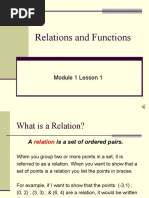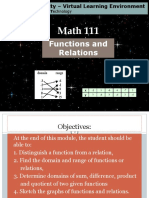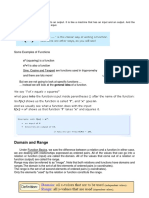A. Definition of A Function: Video Tutorial For Parts A, B, C
Uploaded by
momathtchrA. Definition of A Function: Video Tutorial For Parts A, B, C
Uploaded by
momathtchrFunctions
1
Objectives:
- Determine whether a relation represents a function (p. 43)
- Find the value of a function (p. 46)
- Find the domain of a function defined by an equation (p. 49)
- Form the sum, difference, product, and quotient of two functions (p. 51)
A. Definition of a Function
Determine if the relation defines y as a function of x. For each function,
state the domain and range.
Video tutorial for Parts A, B, C
1. { (-2, 5), (-1, 3), (3, 7), (4, 12)}
2. {(-4, 4), (-3, 3), (-2, 2), (-1, 1), (-4, 0)}
- A function is a rule. A function f is a rule that assigns to each element x in a set
A exactly one element, f(x), in a set B.
- Given a relation in x and y, we say y is a function of x if for every element x
in the domain, there corresponds exactly one element y in the range.
- This just means that a function cant repeat any x-coordinates
- A function can repeat y-coordinates
- Any set of ordered pairs (x, y) is called a relation in x and y.
- The set of first components in the ordered pairs is called the domain of the
relation
- The set of second components in the ordered pairs is called the range of the
relation
- Hint: Domain vs. Range
o D comes before R in the alphabet, just as x comes before y
o So, D goes with x and R goes with y
- When you list the numbers in the Domain and Range
o List each number only ONCE
Functions
2
B. Determining Whether an Equation is a Function
Determine whether the equation defines y as a function of x.
1.
2
1
x
y = 2. x y 3 5 = 3.
2
2y x = 4. 1 2 3
2 3
+ = x x y
C. The Vertical Line Test
Use the Vertical Line Test to determine whether the relations define y as
a function of x.
1. 2.
3. 4.
- Solve the equation for y. If you get two solutions for y, the equation is not a
function.
- Some equations that are NEVER a function:
o An equation that has y
2
is never a function
o An equation that has represents two solutions and is not a function
How do we determine if a relation is a function from a graph?
Apply a Vertical Line Test
If a vertical line passes through two points, or through the graph twice, it,
FAILS the Vertical Line Test, and it is NOT a function
Functions
3
D. Obtaining Information about the Graph of a Function
Video tutorial
Consider the function: ( )
2
1
2
+
=
x
x
x f
a) Is the point (2, 1) on the graph of f?
b) If x = 4, what is f(x)? What point is on the graph of f?
c) If f(x) = -8, what is x? What point(s) are on the graph of f?
d) List the x-intercepts, if any, of the graph of f.
e) List the y-intercept, if there is one, of the graph of f.
f) What is the domain of f?
g) What are the zeros of f?
Functions
4
a) Find ( ) 0 f and ( ) 6 f .
b) Find ( ) 2 f and ( ) 2 f .
c) Is ( ) 3 f positive or negative?
d) Is ( ) 1 f positive or negative?
e) For what values of x is f(x) = 0?
f) For what values of x is f(x) < 0?
g) What is the domain of f ?
h) What is the range of f ?
i) What are the x-intercepts?
j) What are the y-intercepts?
k) How often does the line y = -1
intersect the graph?
l) How often does the line x = 1
intersect the graph?
m) For what value of x does f(x) = 3?
n) For what value of x does f(x) = -2?
o) What are the zeros of f ?
E. Use the given graph of the function f to answer parts (a) (o).
Video tutorial a-g
Video tutorial h-o
Functions
5
F. Determine whether the graph is that of a function by using the
vertical-line test. If it is, use the graph to find:
a)The domain and range b) The intercepts, if any c) Any symmetry with respect to the x-axis, the y-
axis, or the origin.
1.
Video tutorial #1
2.
Video tutorial #2
Functions
6
3.
Video tutorial #3
4.
Video tutorial #4
Functions
7
G. Function Notation
Evaluate the function at the indicated function values.
When a function is defined by an equation, we often use function notation.
For example, y = 2x can be written as ( ) 2 f x x = .
f is the name of the function. (It can be g(x) or h(x), etc
x is an input value from the domain of the function
f(x) is the function value (y-value) corresponding to x.
The notation f(x) is read as f of x or the value of the function f at x
A function may be evaluated at different values of x by substituting x-values
from the domain into the function.
The ordered pairs you get are the same as (x, y), but they are (x, f(x))
So, if f(5) = 10, the ordered pair is (5, 10).
( )
( )
( )
( )
( ) =
=
= +
=
x f
x f
x f
f
f
2
1
1
0
Video tutorial for #1
1. ( ) 1 2
2
+ = x x x f
Functions
8
2. ( ) 2 3 f x x =
(5)
( 4)
f
f
=
=
Video tutorial for #2
( )
( )
( )
( )
( )
( ) =
=
=
= +
= +
=
x f
x f
x f
x f
h x f
f
2
1
0
Video tutorial for #3
3.
( )
5 3
1 2
+
=
x
x
x f
Functions
9
H. How do you find the domain?
Find the domain of the function in interval notation.
1.
7
( )
2 1
x
f x
x
+
=
Video tutorial for #1-9
2.
2 1
9
x
x
+
3.
2
4
( )
9
x
f x
x
=
+
4.
1) Is it a fraction?
a. Set the denominator equal to zero and solve for x.
b. Domain: ( ) ( ) ___, ___ ,
2) Is it an even index radical?
a. Set the inside expression >0 and solve for x.
b. Domain: | ) ( | ___ , be could it or ___,
3) All other expressions
a. Domain is all real numbers or: ( ) ,
( ) 1 2
2
+ = x x x f
Functions
10
5. ( ) 4 f x t = +
6. ( ) 3 4 f x x =
7.
2
( ) 3 f x t t =
8.
5
( )
x
f x
x
=
9. ( ) 8 f x x t =
You might also like
- Lesson 1 - Functions, Function Notation, Domain & RangeNo ratings yetLesson 1 - Functions, Function Notation, Domain & Range27 pages
- RELATIONS-AND-FUNCTIONS (Mathematics in The Modern World)No ratings yetRELATIONS-AND-FUNCTIONS (Mathematics in The Modern World)38 pages
- 2-1: Graphing Linear Relations and Functions: ObjectivesNo ratings yet2-1: Graphing Linear Relations and Functions: Objectives19 pages
- Relations and Functions: Module 1 Lesson 1No ratings yetRelations and Functions: Module 1 Lesson 124 pages
- Relations and Functions: Module 1 Lesson 1No ratings yetRelations and Functions: Module 1 Lesson 124 pages
- Precalculus: Quarter I - ILM 2 FunctionsNo ratings yetPrecalculus: Quarter I - ILM 2 Functions15 pages
- Lecture Transcript 1 Introduction To Functions and Piecewise Functions7No ratings yetLecture Transcript 1 Introduction To Functions and Piecewise Functions714 pages
- MATH165 CO1 Lesson 1.8 Intro To FunctionsNo ratings yetMATH165 CO1 Lesson 1.8 Intro To Functions22 pages
- Chapter 3 - Functions With Solution20 Jun2013No ratings yetChapter 3 - Functions With Solution20 Jun201349 pages
- Chapter 1: Functions and Their Graphs Lesson 1: Functions About The LessonNo ratings yetChapter 1: Functions and Their Graphs Lesson 1: Functions About The Lesson17 pages
- MM3&4 - Functions and Transformations Summary NotesNo ratings yetMM3&4 - Functions and Transformations Summary Notes16 pages
- Notes 1 Functions and Their Graphs (Calculus 1)No ratings yetNotes 1 Functions and Their Graphs (Calculus 1)14 pages
- 01 Functions, Function Notation, Domain & RangeNo ratings yet01 Functions, Function Notation, Domain & Range27 pages
- Sets and Venn Diagrams To Solve ProblemsNo ratings yetSets and Venn Diagrams To Solve Problems4 pages
- A. Venn Diagrams For 2 Sets: Lesson 2-3 Usingvenn Diagrams To Study Set OperationsNo ratings yetA. Venn Diagrams For 2 Sets: Lesson 2-3 Usingvenn Diagrams To Study Set Operations6 pages
- Hesterfield Illage: Annual Board Meeting-Your Help Is Needed!No ratings yetHesterfield Illage: Annual Board Meeting-Your Help Is Needed!4 pages
- Square Root Property and Completing The Square VideosNo ratings yetSquare Root Property and Completing The Square Videos4 pages
- Pool Opening Information: Hesterfield IllageNo ratings yetPool Opening Information: Hesterfield Illage2 pages
- A. Definition of A Relation: Video Tutorial For #1-6No ratings yetA. Definition of A Relation: Video Tutorial For #1-65 pages
- Index Mappings For The Fast Fourier Transform: IEEE Transactions On Signal Processing April 1996No ratings yetIndex Mappings For The Fast Fourier Transform: IEEE Transactions On Signal Processing April 19964 pages
- System of Linear Equations Direct MethodsNo ratings yetSystem of Linear Equations Direct Methods21 pages
- Paper 1 Topical Examination Questions by KDC 2024No ratings yetPaper 1 Topical Examination Questions by KDC 202451 pages
- Mathematics Conclusion Proposition ProofNo ratings yetMathematics Conclusion Proposition Proof12 pages
- Solving Algebra Equations With FractionsNo ratings yetSolving Algebra Equations With Fractions2 pages
- CU-2020 B. Com. (Honours) Advanced Business Mathematics-M2 Semester-V Paper-DSE-5.1 QPNo ratings yetCU-2020 B. Com. (Honours) Advanced Business Mathematics-M2 Semester-V Paper-DSE-5.1 QP2 pages
- Download A Concrete Introduction to Real Analysis, Second Edition Robert Carlson ebook All Chapters PDF100% (1)Download A Concrete Introduction to Real Analysis, Second Edition Robert Carlson ebook All Chapters PDF55 pages
- Gradient Descent Intuition: Back To Week 1 LessonsNo ratings yetGradient Descent Intuition: Back To Week 1 Lessons3 pages
- Finite Element Method: Physics and Solution Methods 1st Edition Sinan Muftu - The ebook is now available, just one click to start reading100% (1)Finite Element Method: Physics and Solution Methods 1st Edition Sinan Muftu - The ebook is now available, just one click to start reading69 pages
- Integrals Involving Inverse Trigonometric FunctionsNo ratings yetIntegrals Involving Inverse Trigonometric Functions10 pages
- Eulers-Method Best Example of Using Euler Method in Chemical ReactionNo ratings yetEulers-Method Best Example of Using Euler Method in Chemical Reaction48 pages
- Engineering Statistics and Probability Chapter 3 PDFNo ratings yetEngineering Statistics and Probability Chapter 3 PDF25 pages
- NE of The Most Important Applications Of: Generalized Plane Wave Horn TheoryNo ratings yetNE of The Most Important Applications Of: Generalized Plane Wave Horn Theory13 pages
- Lesson 1 - Functions, Function Notation, Domain & RangeLesson 1 - Functions, Function Notation, Domain & Range
- RELATIONS-AND-FUNCTIONS (Mathematics in The Modern World)RELATIONS-AND-FUNCTIONS (Mathematics in The Modern World)
- 2-1: Graphing Linear Relations and Functions: Objectives2-1: Graphing Linear Relations and Functions: Objectives
- Lecture Transcript 1 Introduction To Functions and Piecewise Functions7Lecture Transcript 1 Introduction To Functions and Piecewise Functions7
- Chapter 1: Functions and Their Graphs Lesson 1: Functions About The LessonChapter 1: Functions and Their Graphs Lesson 1: Functions About The Lesson
- MM3&4 - Functions and Transformations Summary NotesMM3&4 - Functions and Transformations Summary Notes
- Geometric functions in computer aided geometric designFrom EverandGeometric functions in computer aided geometric design
- A. Venn Diagrams For 2 Sets: Lesson 2-3 Usingvenn Diagrams To Study Set OperationsA. Venn Diagrams For 2 Sets: Lesson 2-3 Usingvenn Diagrams To Study Set Operations
- Hesterfield Illage: Annual Board Meeting-Your Help Is Needed!Hesterfield Illage: Annual Board Meeting-Your Help Is Needed!
- Square Root Property and Completing The Square VideosSquare Root Property and Completing The Square Videos
- A. Definition of A Relation: Video Tutorial For #1-6A. Definition of A Relation: Video Tutorial For #1-6
- Index Mappings For The Fast Fourier Transform: IEEE Transactions On Signal Processing April 1996Index Mappings For The Fast Fourier Transform: IEEE Transactions On Signal Processing April 1996
- CU-2020 B. Com. (Honours) Advanced Business Mathematics-M2 Semester-V Paper-DSE-5.1 QPCU-2020 B. Com. (Honours) Advanced Business Mathematics-M2 Semester-V Paper-DSE-5.1 QP
- Download A Concrete Introduction to Real Analysis, Second Edition Robert Carlson ebook All Chapters PDFDownload A Concrete Introduction to Real Analysis, Second Edition Robert Carlson ebook All Chapters PDF
- Gradient Descent Intuition: Back To Week 1 LessonsGradient Descent Intuition: Back To Week 1 Lessons
- Finite Element Method: Physics and Solution Methods 1st Edition Sinan Muftu - The ebook is now available, just one click to start readingFinite Element Method: Physics and Solution Methods 1st Edition Sinan Muftu - The ebook is now available, just one click to start reading
- Integrals Involving Inverse Trigonometric FunctionsIntegrals Involving Inverse Trigonometric Functions
- Eulers-Method Best Example of Using Euler Method in Chemical ReactionEulers-Method Best Example of Using Euler Method in Chemical Reaction
- Engineering Statistics and Probability Chapter 3 PDFEngineering Statistics and Probability Chapter 3 PDF
- NE of The Most Important Applications Of: Generalized Plane Wave Horn TheoryNE of The Most Important Applications Of: Generalized Plane Wave Horn Theory











































































































